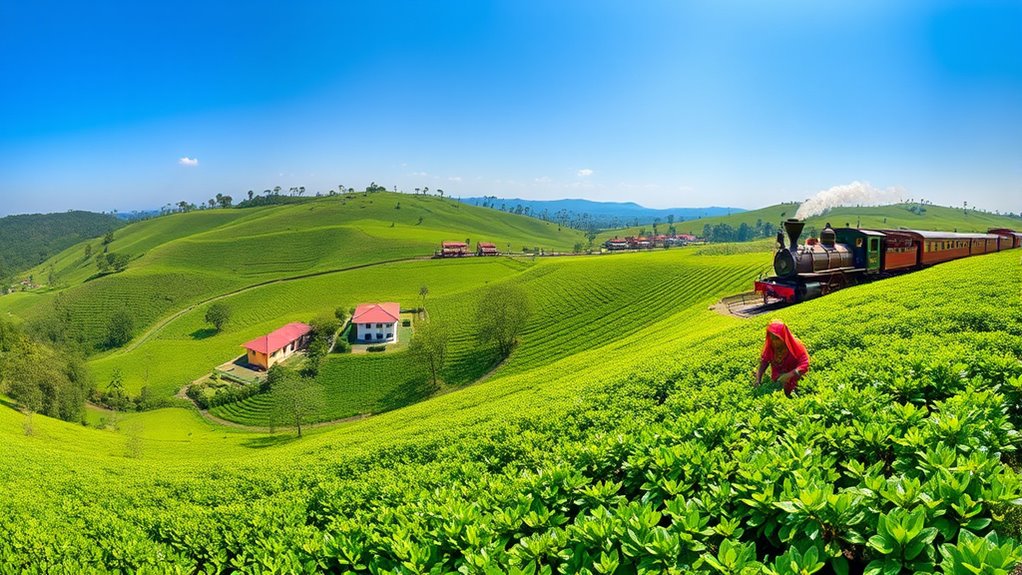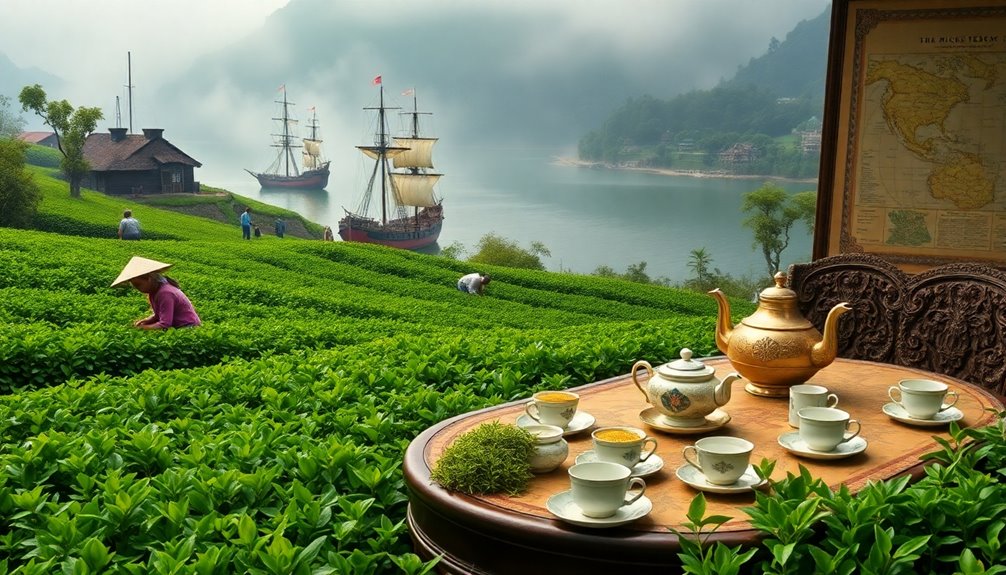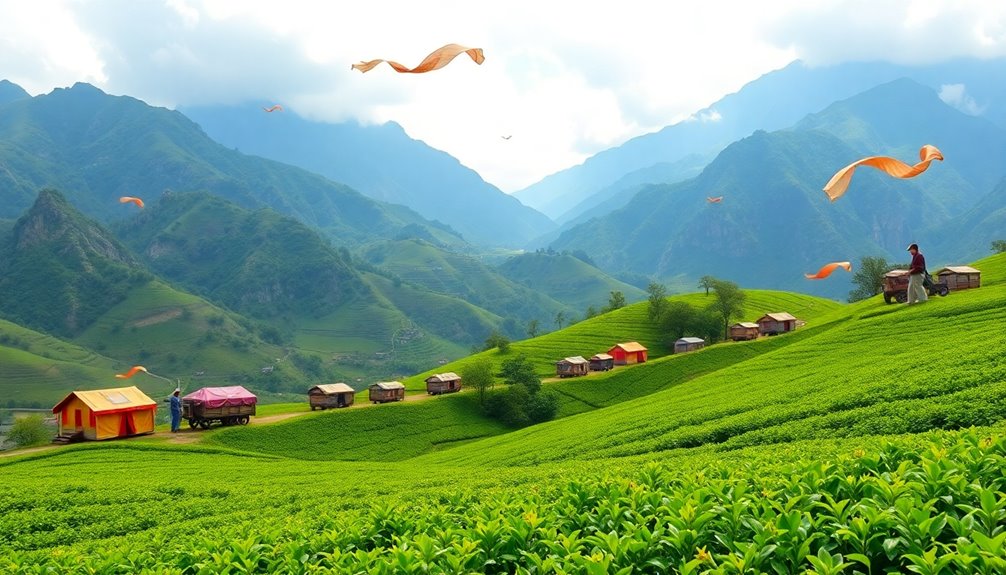Sri Lanka’s tea industry began during colonial times when the British established plantations to meet global demand. Over time, it transformed into a symbol of resilience and craftsmanship, blending tradition with innovation. The industry’s success relies on quality, sustainable practices, and adaptation to modern techniques. Despite global shifts, Sri Lanka continues to grow as a premium tea producer. To explore how this rich history shapes its current global impact, keep exploring the evolution of Sri Lanka’s tea craft.
Key Takeaways
- The Sri Lanka tea industry originated in colonial times with British-established plantations to meet European demand.
- It evolved into a global leader by focusing on high-quality Ceylon tea and export growth.
- The industry balances traditional methods with innovative practices to maintain unique flavors and competitiveness.
- Sustainable practices and skilled labor support the industry’s resilience and long-term viability.
- Despite economic challenges, Sri Lanka’s tea industry continues to reflect its colonial legacy and modern craftsmanship.

Sri Lanka’s tea industry has a rich history that reflects its resilience and global influence. When you think about the origins of this industry, you can’t ignore the importance of tea plantations that sprouted across the island during colonial times. These plantations transformed Sri Lanka into one of the world’s leading tea producers, shaping its economy and cultural identity. Initially established by the British in the 19th century, the tea plantations were designed to meet growing demands from Europe and North America. As you observe the landscape today, it’s clear that these plantations have become symbols of both colonial legacy and local craftsmanship. Over the decades, the industry has evolved, focusing not just on quantity but also on quality, which has helped boost export growth considerably.
You might notice that the growth of exports has played an essential role in elevating Sri Lanka’s reputation in the global tea market. The country’s ability to produce high-quality tea consistently has opened new markets and strengthened existing ones. This export growth isn’t just about increasing shipment numbers; it’s about maintaining standards that appeal to discerning buyers worldwide. As a result, Sri Lanka has positioned itself as a premium tea supplier, known for its Ceylon tea, which remains a sought-after product in international markets. The industry’s success is rooted in a combination of factors: the favorable climate, skilled labor, and a commitment to sustainable practices. These elements guarantee that the tea produced on Sri Lanka’s plantations meets the expectations of global consumers, fueling continued growth.
Furthermore, the industry’s journey from colonial roots to a modern, craft-focused sector is evident in the way local producers now emphasize quality and tradition alongside modernization. You’ll find that many tea estates have adapted by incorporating innovative techniques while preserving age-old methods that define Sri Lanka’s unique flavor profiles. This balance between tradition and innovation has helped boost export figures, making Sri Lanka a key player in the international tea scene. Additionally, the industry’s focus on sustainable practices demonstrates its commitment to environmental stewardship and social responsibility, ensuring its resilience for future generations. The industry’s resilience is clear—despite economic challenges and global shifts, Sri Lanka’s tea exports continue to grow, driven by a deep-rooted passion for craft and excellence. As you observe the ongoing developments, it’s evident that Sri Lanka’s tea industry not only reflects its colonial past but also exemplifies a vibrant, evolving craft that sustains its place on the world stage.
Frequently Asked Questions
How Has Climate Change Affected Sri Lanka’s Tea Production?
You might notice that climate change has substantially impacted Sri Lanka’s tea production through environmental impacts like unpredictable weather patterns, droughts, and increased pests. To adapt, farmers are adopting climate adaptation strategies such as shifting planting schedules and developing resilient tea varieties. These efforts help mitigate risks, but ongoing environmental impacts challenge the industry’s sustainability, urging continuous innovation and adaptation to preserve Sri Lanka’s renowned tea legacy.
What Are the Primary Challenges Facing Small-Scale Tea Farmers Today?
Small-scale tea farmers face formidable future fears. Limited market access leaves you longing for better opportunities, while price volatility causes constant concern over income stability. You struggle with securing fair prices amidst fluctuating markets, making it hard to sustain livelihoods. These challenges demand decisive action, as you navigate the nuances of a competitive industry, fighting for fair treatment and financial freedom in an unpredictable economic environment.
How Does Sri Lanka Ensure Sustainability in Its Tea Industry?
You can see Sri Lanka promotes sustainability in its tea industry through eco-friendly practices that reduce environmental impact and conserve resources. Fair trade initiatives ensure fair wages and better working conditions for farmers, promoting social sustainability. By adopting organic farming methods and supporting local communities, Sri Lanka fortifies its reputation as a responsible producer, helping to preserve its heritage while meeting global demand for ethically sourced, high-quality tea.
What Innovations Are Emerging in Sri Lanka’S Tea Processing Techniques?
You’ll find that Sri Lanka’s tea processing techniques are evolving with innovative machinery and advanced tea fermentation methods. These innovations streamline production, improve quality, and reduce environmental impact. You might notice new machinery that automates sorting and rolling, making processes faster and more precise. Additionally, modern tea fermentation techniques enhance flavor profiles, allowing producers to create unique blends. These advancements help Sri Lanka maintain its reputation for high-quality tea while embracing sustainability and efficiency.
How Has Global Demand Influenced Local Tea Agriculture Practices?
You see that global markets and export policies greatly influence Sri Lanka’s tea agriculture practices. As international demand rises, you’re encouraged to adopt higher-quality techniques and sustainable methods to meet export standards. These policies push you to optimize yield and quality, ensuring your tea appeals to global consumers. Ultimately, this relationship shapes how you cultivate, process, and market your tea, aligning local practices with the needs of the world’s markets.
Conclusion
Your journey through Sri Lanka’s tea industry shows how resilience transforms history into a lush legacy. Like a mighty river carving its path through stone, the industry’s growth reflects perseverance and adaptation. From colonial roots to a global icon, this vibrant sector continues to thrive because of your dedication and passion. Remember, just as tea leaves reveal their richness when nurtured, your efforts shape a future as vibrant and enduring as Sri Lanka’s cherished brew.










